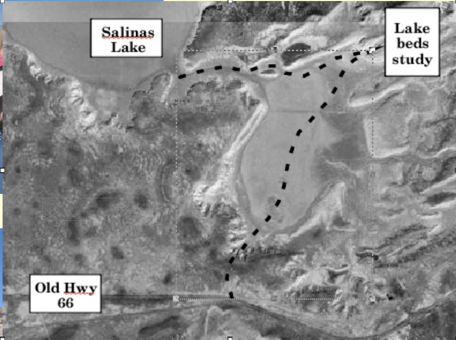Lake Estancia Field Trip 4-26-2003
Led by Dr. Roger Anderson
FOLLOWING IS A SHORT EXERPT FROM A PAPER BY DRS. ANDERSON & ALLEN
Geomorphic Expression of Abrupt Climate Change in Southwestern North America at the Glacial Termination
Roger Y. Anderson
Department of Earth and Planetary Sciences, University of New Mexico, Albuquerque, New Mexico 87131
Bruce D. Allen
New Mexico Bureau of Geology and Mineral Resources, New Mexico Institute of Mining and Technology, Socorro, New Mexico 87801
INTRODUCTION
Late Pleistocene Lake Estancia in the 5000 km2 Estancia basin of central New Mexico rose and fell at least nine times during the 12,000 yr that preceded the glacial termination (Allen and Anderson, 2000). Radiocarbon ages of highstand deposits are sufficient to show that increases in moisture and rising lake levels occurred concurrently with stadial indicators in high-latitude ice cores (e.g., Alley et al., 1993; Taylor et al., 1997) and were antiphased with high lakestands at lower latitudes in the Northern Hemisphere (e.g., Broecker et al., 1998).
The lake reached an elevation of 1890 m and a surface area of -1100 km2 at least five times during the last glacial maxi- mum (LGM) and again shortly after 14,000 yr BP. Age relations and stratigraphic evidence indicate that the lake rose and fell rapidly, in some cases within several decades (Allen and Anderson, 1993), suggesting that climate was punctuated by rapid increases and decreases in the supply of atmospheric moisture reaching the western interior of North America.
Lake Estancia disappeared completely after ca. 12,000 yr BP, leaving a single 400-km' playa on the floor of the basin. Desiccation capped the playa surface and underlying sequence of lake beds with a white, half-meter-thick layer of gypsum and magnesite. Some time after the episode of drying, a perennial lake reappeared in the Estancia basin. The returning lake overrode gypsum sand in what appears to have been a dune field that developed on the floor of the basin, reworked the sand into beach ridges, and left evidence for a final highstand in one of the easternmost pluvial lake basins in western North America. We have indirect and limited evidence for the age of the final lake stand, which suggests that the last highstand in the Estancia basin could correspond to the Younger Dryas (YD; 11,000 to l0,000 yr B.P; 12,500 to 11,300 cal yr B.P.) climatic episode.
Eolian landforms on the old lake floor, constructed from gypsum sand, appear to have survived rising lake waters and currents in the shallow lake, suggesting abrupt changes in lake level. Here we present geomorphic and stratigraphic evidence for eolian deposition and subsequent modification by subaqueous processes and propose that the final highstand represents the last in a series of pulsations in the supply of atmospheric moisture to western North America.
Examining old beach ridges


Salt Lakes

Lake Beds


Trip Route
Dr. Anderson